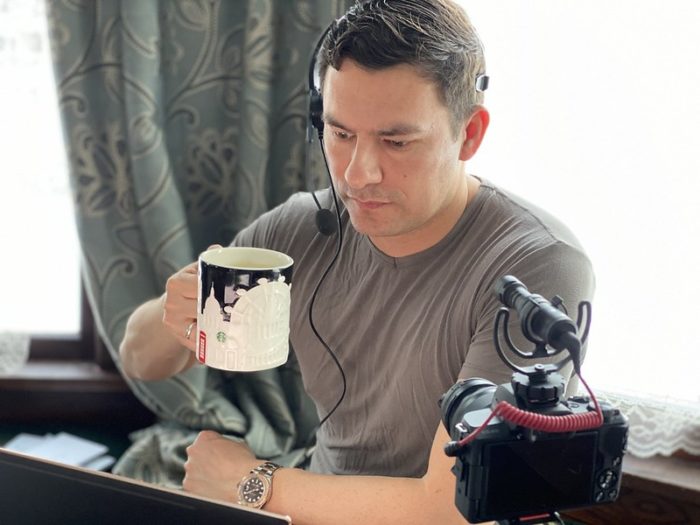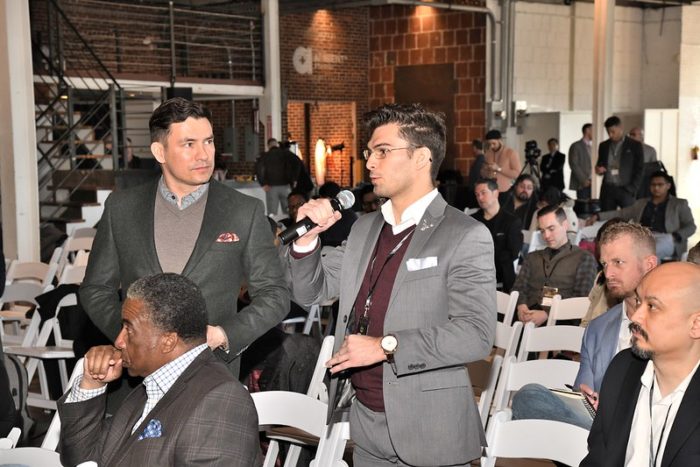

Imagine…
The sea of faces.
The expectant hush.
Butterflies in your stomach.
Sweaty palms.
This is the presentation of your life.
It’s going to make or break your career.
Your heart pounds as you listen to yourself drone on… watch their eyes glaze over…
And feel your career going down the drain.
Death by PowerPoint.
Today, we are going to throw you a lifeline. I have 13 public speaking mistakes for you to avoid to make sure you never fail another presentation in your life!
#1 Public Speaking Mistake: Not Knowing Your Audience


You need to know who you’re speaking to–in general and as individuals–to avoid losing them to confusion or giving them irrelevant information.
Ask yourself two questions: why are they here, and what do they already know?
By understanding how much your audience knows about the topic, you can avoid filler words in presentations or examples they don’t understand, but also avoid talking down to them.
Knowing what they want to find out helps you stay relevant and hold their interest.
Stand on their side of the podium for a moment. What motivates them to be there? What could you tell them that would make them glad they came?
Research who you’ll be speaking to. Knowing the age group, professions, and other demographics of your audience will help you decide what points are most likely to click.
If your audience is from a different generation, company, or background, try to get a feel for their culture so you don’t say anything that will come off as rude.
You can also use this to tailor references and humor to their taste, but understand that that’s not a substitute for genuine respect. Trendy internet slang isn’t the key to reaching an audience of high school students–showing you respect their intelligence even as you speak from an older perspective is.
#2 Not Emotionally Connecting


There’s a reason your audience didn’t just google the info you’re telling them: they want to hear it from a person. They came to hear your human perspective and to experience the connection you can offer them
The best presentations are ones that create a deep personal connection, and one thing we all share as human beings are feelings of fear or vulnerability. If you’re willing to open up about yours, it can help people feel a stronger connection with you.
My personal example: I will, in the course of talks, sometimes talk about suicide, which is an issue that’s touched me closely in my family and in my military service. Getting people the help they need to try and prevent suicide is something I’m involved with and something that means a lot to me.
I don’t bring it up to impress people or to try and make them feel like they need to get involved, but I will mention it to show people that hey — I am a guy who does care and think about serious stuff, beyond whatever the topic of the moment is.
“The best presentations are ones that create a deep personal connection, and one thing we all share as human beings are feelings of fear or vulnerability.”
And most people are like that! They have some things they care very deeply about, or have strong feelings about, or are committed to or involved with in a serious way. Hearing about mine reminds them of theirs, and then we have a connection as real human beings.
Let them know how you feel about what you’re telling them – they’ll internalize it. Feel free to mention relevant things that you care about as examples. It helps your audience feel like they know you.
#3 Winging It


Under-preparing is a common mistake that can ruin a presentation with tons of potential. If you’re not prepared, you can’t relax. And if you don’t relax, you’re unlikely to engage at the level that the best public speakers do.
Have a plan B in case of technical difficulties, come up with alternate examples in case your original ones don’t seem to be landing and arrive early.
Check your equipment and everything you’ll need well before it’s time to start the speech. If you can, do a run-through on-venue–a full dress rehearsal, if you will.
If you’re prepared well in advance, you can use any extra time at the beginning to talk with individuals. It’ll help your audience feel more comfortable with you.
#4 Death By Powerpoint


Visual aids can make your speech clearer and easier to follow, but not if they’re text-heavy, hard to read, or distracting.
Most people know you shouldn’t read text straight from your PowerPoint slides, but you should be keeping text basic overall. You want it to be easy for your audience to note down or remember. Set a target of no more than 10-15 words per slide.
To use PowerPoint effectively, make sure it looks polished and be careful of busy themes and long transitions. You want to keep people’s interest on what you’re saying, not distract from it.
#5 Not Practicing Enough


The keys to a good presentation are confidence, flexibility, engaging your audience, and knowing your stuff.
How do you get there? Practice.
The better you know your material, the more relaxed you’ll be and the more confident you’ll come across.
Start practicing at least several days in advance.
You want everything committed to long-term memory. Until you can give your speech while driving, doing the dishes, or walking through an unfamiliar conference center, you shouldn’t tell yourself you’ve “practiced enough.”
On your later run-throughs, hone the details. Test out how you want the presentation to feel–what the arc of it will be, where it’s most high-energy.
Don’t just memorize the bullet points. Match them to your tone and gestures.
#6 Not Knowing What You’re Talking About


Obviously, you want to give your audience accurate information. They’re there to learn. But doing your homework before a presentation is important for another reason: credibility.
The audience doesn’t have to know everything about the topic to catch an outdated fact or a statistical mix-up. And if they do, they’ll wonder about the accuracy of every single thing you’re saying.
Building credibility keeps people paying attention because they know what you’re saying is useful. They feel like they can trust you to answer their questions and give them the straight talk about the topic. It goes without saying, but you want to avoid being embarrassed during the Q & A too.
If you’re tripped up by a question or need to double check a fact, it’s worse to say something wrong than it is to excuse yourself and quickly check your notes. At the end of the day, honesty is more valuable than smoothly rattling off incorrect info.
#7 No Excitement


Especially if you’re at a conference or in an office setting where people are going to meetings regularly, they’ve probably already seen a lot of people just standing there talking.
If you can give them a fresh experience, they’ll listen more closely to your points and you’ll make an impression.
When you practice, get comfortable moving around. Don’t hide behind the podium.
Choose your anecdotes carefully, and tell them like you’d tell a story to your friends. If they’re interesting in their own right, they’ll do a way better job of illustrating your points because your audience will remember them.
Make sure the relevancy is spot-on though, or they’ll remember the story and not the point.
#8 Going On Too Long


People naturally pay attention in bursts of 15-20 minutes. Ask yourself if you really need to talk for longer. If you do, try to divide your speech into segments with a brief pause between each one.
Almost all presentations go on for longer in front of an audience. Practice until you can do it comfortably in less than the allotted time.
If you can save someone time then you instantly become a high value man in their eyes. Worst case scenario, you keep it brief and have more time for questions afterward.
Timing your statements keeps your message interesting longer. This is as true for public speaking as it is for stand-up comedy. Figure out how to make basic points as briefly as possible, then fill in the details where you have time.
#9 Not Engaging Your Audience


Talk about things you know your audience is going to be interested in. If you can, talk about your topic in terms of their lives specifically.
As you speak, try to stick with mostly “you” statements. You should be constantly feeding the audience’s perception that this is directly relevant to them. A close second option is using “we” statements, creating the feeling that you and the audience are a team.
If you’re presenting to a small group, like a gathering around a conference table, you can alternate meeting each person’s eyes directly. For larger groups, move your gaze around the room.
Interact with your audience as much as you can. Ask them questions. Open the floor up to brainstorming. If they’re participating, they’ll be paying attention.
#10 Not Observing Other Speakers


Never miss an opportunity to watch other public speakers in action.
Go to talks when you’re at conferences. Watch videos like mine online. Check the bulletin boards at your local college or library for public lectures (you can learn some really weird and cool stuff from those, too).
Exposing yourself to a wide range of speakers shows you both the good and the bad of public speaking.
I got to watch Ian Cleary of Razor Social speak recently, who’s an absolute master of the craft, and I was thinking to myself “man, I’ll never be as good as this guy.”
But at the same conference I saw enough presentations that made me think “okay, I’m at least this good” that I could feel positive about my skills, and aspire to get them closer to Ian’s level by learning from him!
#11 Not Moving Around


Whatever room you’re in, own it!
Don’t hide behind the podium.
Move around and gesture when you talk. It’s much better to look too energetic than not energetic enough.
In a lot of public speaking settings (like business meetings and conferences), people have been doing the same sit-and-listen routine for a long time. You want to offer them something that looks and feels different to get them out of their mental rut.
In one presentation that I did with John Dumas of Entrepreneur on Fire, we only had 20 people or so and a fairly small space. When we got there, we moved the chairs into a big circle and had one “hot-seat” at the center that different people took at different points in the presentation.
The change in structure really helped break up the feeling of sitting and staring at screens while someone talks from up on stage. It gave people a sense that they were there getting one-on-one advice from some guys with big successes under their belt, which made the whole experience feel very valuable to them. We got great feedback on that one.
#12 Not Utilizing the Correct Body Language
Your body language adds credibility to your speech. Avoid crossing your arms (this is a defensive gesture which puts up a barrier between you and the audience) and try to avoid fiddling with your cuffs, wallet or buttons because this makes you look nervous.
Take time to watch how the professionals do it and remember to work the room.
That means not standing in one place like a statue – you should be animated to keep your audience’s attention.
Want to learn more about body language moves that can help you gain trust? Click here to check out the 3 Secret Body Language Moves That Help You Gain Instant Trust.
#13 Not Realizing Unconscious Bad Habits
You’ll spot some bad habits as you work on your body language – things like putting your hands in your pockets or touching your face while speaking.
But I’m willing to bet you also have some bad verbal habits. Watch out for ‘filler words’. Words like:
- Uh
- So
- Well
- You know
- Like
- I mean
- Anyway
- As I was saying
These weaken the impact of what you’re saying and make you come off as unsure, unprepared, and nervous.
How to break yourself of the habit? Try making a game of it. Create a ‘filler word jar’ and drop a quarter in there every time you use a filler word. Speaking without filler words will feel odd, but you can go a long way towards breaking this habit in just one day.